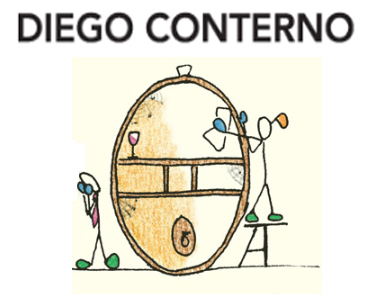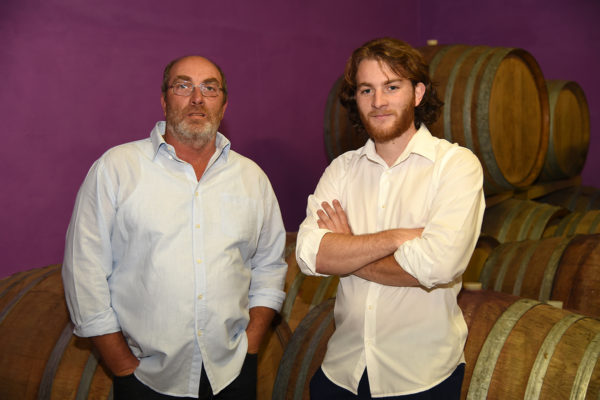
The Estate
To Diego Conterno, wine is passion, interpretation, and art. It reflects the identity of a terroir: in this case, the Langhe of Monforte d’Alba. Diego has been considering the vineyards, the grapes, and the wine from this point of view for over 30 years.
Diego developed his knowledge of wine at the Umberto I School of Enology and also while working under the legendary Piedmont winemaker Beppe Colla of Prunotto. In 1982, he started a successful enterprise with his cousins Claudio and Guido Fantino, which lasted until 2000. With the start of the new century, Diego felt ready to face new challenges. He sold his share of Conterno-Fantina and founded his own winery under his name, bringing with him his vines which included a prime Ginestra plot.
Diego built his winery in Monforte d’Alba on a hill surrounded by vineyards – incidentally just up the slope from the vineyards of Giacomo Conterno (no relation). The estate covers an area of 7.5 hectares, of which 2 hectares are Ginestra vines (the full south-facing portion of the plot called Sori was first planted in 1982).
The first vintage under the label Diego Conterno was 2003. In 2010, Diego’s son Stefano joined the operation, and today he works side-by side with his father cultivating the vines and making the wine.
The Conterno philosophy is simple: when you taste a wine, you have to experience the characteristics of the terroir. This is created in the vineyards and finds expression in the grapes. Each wine has its own history and soul, and tells us about a part of the Langhe region of Monforte d’Alba. The wines by Diego Conterno are all organic and represent life: from Dolcetto to Barolo, through Barbera and Nebbiolo d’Alba, the stages of our lives are written in the characteristics of each single wine.
Winemaker: Diego & Stefano Conterno
Total Vineyard Area: 7.5 hectares
Average Annual Production: 50,000 bottles

Barolo DOCG
Overview: A selection of grapes from Conterno’s vineyards in Monforte d’Alba: ‘Bricco San Pietro,’ ‘San Giovanni’ (near the village of Barolo) and ‘Ginestra’ (closer to Serralunga), each vinified separately.
Grape Variety: 100% Nebbiolo
Soil: Clay with limestone marl
Altitude: 960-1,140 feet
Average Age of the Vines: 10-30 years old
Training System: Simple Guyot
Average Production: 45 hl/ha
Harvest: Manual
Vinification: The grapes are fully destemmed, followed by fermentation using indigenous yeasts in a temperature-controlled steel tank.
Aging: Combination of 50 hl oak cask and cement tank for 30 months.
Tasting Notes: Medium-bodied wine with aromas of juicy, red cherries, wildflowers, a hint of menthol, and spice. Well-balanced with fine-grained tannins.
Food Pairings: Pairs well with grilled or braised meats.

Barolo Del Comune Di Monforte d'Alba
Overview: “Comune di” is a new designation for Barolo wines in which 85% of the grapes come from a single “comune” or village. This wine is made from a selection of grapes from the Ginestra Cru. The plots used are Pajana (east – 12 years – 340 m) and Ciabot (south east – 20 years – 300 m) – each vinified separately. The label is inspired by an old bottle (1921) of Barolo Ginestra produced by Conterno Lorenzo, great-grandfather of Diego.
Grape Variety: 100% Nebbiolo
Exposition: Southeast, east
Altitude: 900-1,020 feet above sea level
Average Age of the Vines: 15-20 years old
Soil: Clay, sand, and calcareous marls
Training System: Simple Guyot
Harvest: Manual
Vinification: The grapes are fully destemmed, followed by fermentation using indigenous yeasts in a temperature-controlled steel tank.
Aging: 24 months in 50 hl oak barrels, then 8 months in cement tanks.
Tasting Notes: This medium-bodied wine has notes of cherry pie, dried flowers, orange peel, and warm spice.
Food Pairings: Pairs well with grilled or braised meats.

Barolo Ginestra DOCG
Overview: The Conterno family has owned vines in Ginestra for more than 150 years. This single-vineyard Barolo wine is sourced from the full south-facing portion of Ginestra called Sori.
Soil: Clay with limestone marl
Altitude: 870-990 feet above sea level
Grape Variety: 100% Nebbiolo
Average Age of the Vines: About 35 years old
Exposure: The vineyard Ginestra is to the south in Monforte d’Alba, and is situated on a hill between 300 and 350 meters s.l.m.
Harvest: Manual
Vinification: The grapes are fully destemmed, followed by fermentation using indigenous yeasts in a temperature-controlled steel tank.
Aging: 50 hl oak barrels for 24-30 months, followed by 6 months in cement tank and one year in bottle.
Tasting Notes: Deep garnet in color with an elegant bouquet enhanced with persistent fruity, spicy, balsamic, and mineral notes. Full bodied and charismatic on the palate.
Food Pairings: Pairs well with grilled or braised meats.

Nebbiolo d'Alba DOC Baluma
Overview: This wine is produced from the Ferrione vineyard just outside the Barolo zone and near Monforte d’Alba, on the hill “Bricco Monguglielmo.” The name Baluma means “Let’s dance!” in the local dialect, hence the image of a couple dancing on the label.
Exposition: Southwest
Altitude: 1,500 feet above sea level
Soil: The main elements are clay and limestone marl
Grape Variety: 100% Nebbiolo d’Alba
Cultivation System: Guyot
Harvest: Manual
Vinification: The grapes are fully destemmed, followed by fermentation using indigenous yeasts in a temperature-controlled steel tank.
Aging: Aged in oak tonneaux (500L) for 5 months and 4 months in cement tank.
Annual Production: 55 hl/ha
Tasting Notes: Ruby red in color, with a floral and fruity bouquet marked by notes of violet, strawberry, and cherry. On the palate, it expresses fully ripe fruit and a good balance of tannins.

Barbera d’Alba DOC Ferrione
Overview: This wine is made from grapes grown in the Ferrione vineyard adjacent to the winery in Monforte d’Alba, just outside the Barolo zone.
Grape Variety: 100% Barbera d’Alba
Average Age of the Vines: 10-55 years old
Exposition: Southwest
Altitude: 1,500 feet above sea level
Soil: Clay and limestone marl
Training System: Guyot pruning
Harvest: Manual
Vinification: The grapes are fully destemmed, followed by fermentation using indigenous yeasts in a temperature-controlled steel tank.
Aging: 4 months in 500 liter oak barrels followed by 6 months in cement tank so that the acidity and flavor of the classic Barbera can combine to create a fantastic, well-balanced wine.
Average Production: 55 hl/ha
Tasting Notes: Fresh notes of vibrant red fruit and warm spices in the bouquet. Medium-bodied and well-balanced, with fine-grained tannins.
Food Pairings: Grilled and braised meats; pasta with tomato-based sauces.

Dolcetto d'Alba DOC
Overview: The Dolcetto (meaning “little sweet one”) comes from the vineyards in Bricco Monguglielmo of Monforte d’Alba. It is a wine that is best when consumed young, however, its rich aromas are maintained with age which allows this Dolcetto to be appreciated even 2 years after bottling.
Grape Variety: 100% Dolcetto d’Alba
Average Age of the Vines: 10-55 years old
Exposition: South, southwest
Altitude: 1,500 feet above sea level
Soil: Clay, calcareous marl, and tufa
Cultivation System: Guyot
Harvest: Manual
Vinification: The grapes are fully destemmed, followed by fermentation using indigenous yeasts in a temperature-controlled steel tank.
Aging: 6 months in steel and cement tanks.
Annual Production: 50 hl/ha
Tasting Notes: Ruby red with violet hues; the nose is vinous, intense. Notes of red fruit, licorice, and warm spices.
Food Pairings: Pairs well with appetizers, grilled meats, and pork ribs.

Langhe Bianco Nascetta
Overview: Nascetta is the only real indigenous white grape variety from Langhe! In the past, it was mainly used to make sweet wines, usually for religious purposes, but its lovely aromatic complexity makes it ideal for a dry white wine. This wine is a selection from two estate vineyards: Ferrione, on a hillside facing west/southwest; and Ginestra, facing east, in Monforte d’Alba.
Grape Variety: 100% Nascetta
Average Age of the Vines: 10 years old
Exposure: West of the town of Monforte d’Alba, on a hill about 400 meters above sea level
Altitude: 1,440-1,500 feet above sea level
Soil: Medium texture clay with tuff and limestone marl
Harvest: Manual, with selection in the vineyard at the end of September to the beginning of October
Vinification: Two days maceration on skins; pressed then fermented with indigenous yeasts in temperature-controlled tank. Malolactic conversion is blocked.
Aging: 6 months in steel tanks.
Tasting Notes: This wine fully expresses the characteristics of its indigenous landscape. The color is a brilliant bright yellow. The savory and minerally flavors on the palate are accompanied by notes of citrus, pineapple, sage, and rosemary.
Serving Suggestion: Ideal as an aperitif, or paired with sheep cheeses, fish, or white meat. To be consumed young, but also has excellent cellaring potential. Its longevity allows long aging in the bottle with interesting evolutions in flavor.

Barolo Le Coste di Monforte
Overview: This is the flagship wine of the estate, made with grapes obtained from the cool and windy site of Le Coste di Monforte d’Alba, at the southern edge of the Barolo zone. The vineyards face to the south and the grapes give the Barolo Nebbiolo vital tannins, structure, and significant body.
Grape Variety: 100% Nebbiolo
Average Age of the Vines: 30 years old
Exposition: South
Altitude: 1,200 feet above sea level
Soil: Clay and calcareous marl
Cultivation System: Guyot
Harvest: Manual
Vinification: The grapes are fully destemmed, followed by fermentation using indigenous yeasts in a temperature-controlled steel tank.
Aging: Aged in a combination of 50 hl oak casks and cement tank for 30 months.
Annual Production: 45 hectoliters per hectare
Tasting Notes: Notes of wildflowers, rose, cherry, menthol, and spice in the bouquet. Medium-bodied and structured with ripe tannins on the palate.
Food Pairings: Pairs well with grilled or braised meats.


